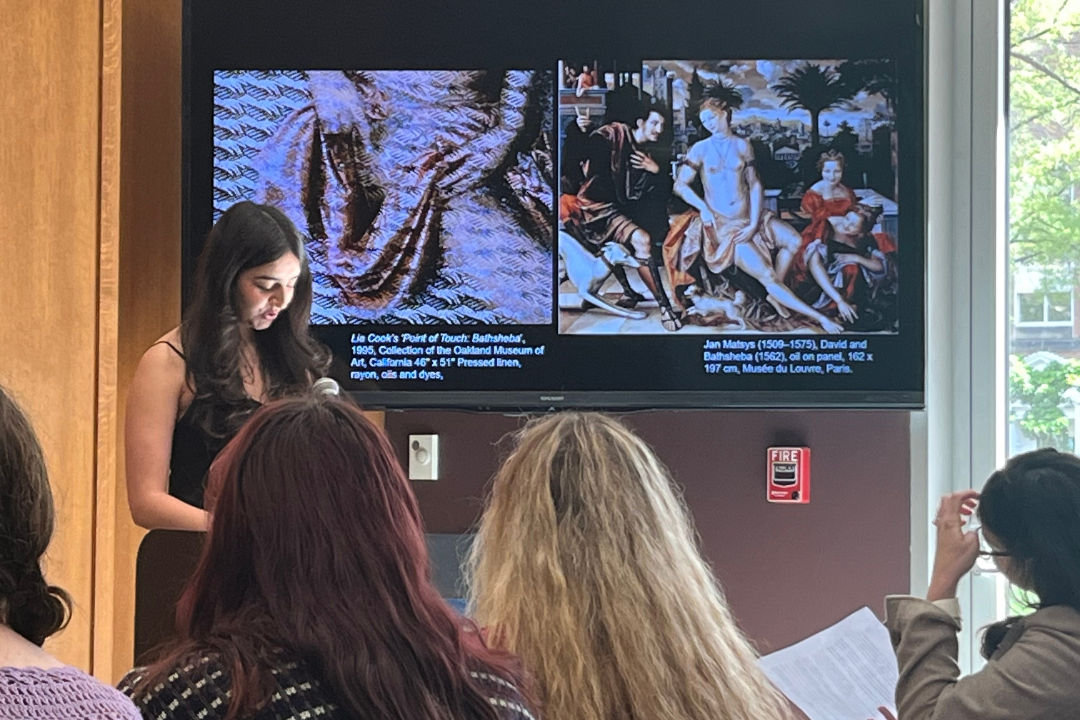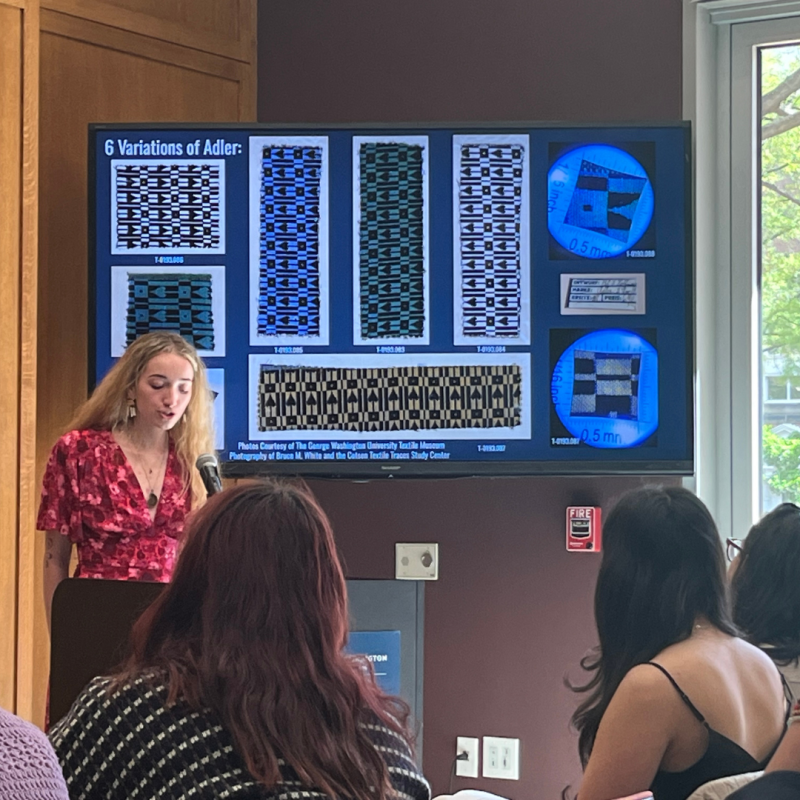By: Maximus Vogt
Esha Devjani presents on Textile Research Day with her slideshow showing Lia Cook’s Work.
Abby Turner presents on Textile Research Day with her slideshow showing the Alder Textiles.
Alex Schroeder presents on Textile Research Day with her slideshow showing “The Souper Dress.”
On the morning of Friday, April 12th the Textile Museum filled with chatter and excitement in anticipation for the presentation of textile research hosted by the museum's Arthur D. Jenkins Library. Amongst these presenters, three emerging scholars from Dr. Rachel Pollack’s new course; Art & History of Textiles read over their notes for the final time before taking to the lectern. Pollack’s course has formed around the intersection of art history and textiles. The foundations of the course are partially inspired by the exhibition Weaving Abstraction, currently on view at The National Gallery of Art, and Making Her Mark: A History of Women Artists in Europe, 1400-1800, a groundbreaking show that just ended this January at the Baltimore Museum of Art. The research opportunities in Pollack's course would not be possible without the assistance of Karthika Audinet, the Academic Coordinator of the Cotsen Textile Traces Study Center. Within the Textile Museum, the Cotsen houses more than 4,000 fragments and objects from around the world, representing the collecting of Lloyd Cotsen throughout his life. Students in Art & History of Textiles also met with Tracy Meserve, librarian for the Arthur D. Jenkins library, aiding in the development of their selected topics throughout the semester.
At the beginning of the course, Pollack assigned her students to write a catalog entry on an object of their choosing from the Cotsen. The work of Esha Devjani, Abby Turner and Alex Schroeder stood out, their research showing the vast scholarship the collection has to offer. Esha Devjani presented on Lia Cook, a contemporary American artist who combines her work in textile with digital technology. Devjani studied the interplay of technology and emotion in Cook’s work, the artist blurring the line between traditional art making methods and digital creation. Devjani noted that Cook experienced a pivotal moment in the 1990’s, prompting her use of the Jacquard loom to produce computer generated textiles. Devjani said this result is a contradiction, her work does not display imperfections and therefore is not human – yet it still evokes emotion and even a sense of human touch. Looking at Cook’s piece at the Cotsen inspired Devjani to reach out to Cook, Cook responded saying that Devjani was correct, that her work is about the desire of touch and tactility. Devjani concluded that Digital art can provoke emotion and even nostalgia, that even when human aspects are removed from art, we can still get human emotions out of it.
Abby Turner researched the Adler textiles in the Cotsen made by Austrian architect and designer Joseph Hoffmann, known for his role as co-founder of the Wiener Werkstätte, a workshop known for its artistic ornamentation of utilitarian items, in line with the Vienna Secession. Turner was originally drawn to the Adler textiles because of their ability to achieve an optical illusion. She discovered that once the fragments were studied under a microscope, the colors in the patterns would change – suddenly the forest green patterned textile revealed blue yarn accents under closer inspection. Turner noted that the blue thread Hoffman added in the textile causes our eyes to mix the green and blue, making the textile appear forest green from further away. She connects this artistic decision to the rise in prominence of color theory at the time, specifically from the philosopher Johann Wolfgang von Goethe’s book, Theory of Colors. Turner asserts that Hoffmann likely took inspiration for his textiles from Goethe’s books, Turner shows the similarity of the Adler textiles next to a diagram from Theory of Colors. Because Turner was initially drawn in by the aesthetic of the Adler textiles, she plans on recreating them in her fine arts practice, hoping that the process will bring up new questions as she continues her research on Hoffmann and the Art Deco movement.
The Cotsen’s “The Souper Dress”, a mod style dress composed of a repeating pattern of Warhol’s Campbell Soup painting was examined by Alex Schroeder as it reveals the history of American consumerism and exposes unsustainable clothing design. Schroeder first explained the rise in consumerism following the end of WWII, the end of the war brought a booming economy and more Americans were left with disposable income. Schreoder said that buying many goods became a sign of “prosperity and patriotism.” One of the goods that became popular was the paper dress, this caused the Campbell soup company to manufacture their own “The Souper Dress” where two soup can labels and one dollar could be sent to the company in exchange for one of these dresses. Schroeder pointed out the irony inherent to the dress, that Warhol’s designs critiqued American society for mass consumption and becoming carbon copies of each other, the consumer flock to buy the dress only proved him right. To connect this concept with contemporary movements for sustainable clothing production, Schroeder said the chemicals used to treat the dress is entirely unsustainable. This process does, however, make the dress fire resistant. In the future, Schroeder said she is interested to study the dress as it relates to second wave feminism.
Pollack said she encourages her students to continue their research as the semester progresses, allowing her students to become well versed in the art historical process while satisfying their university writing requirement. Throughout the semester, her students see the entire process of this scholarship, from catalog entry to exhibition planning, culminating in their final work product. Pollack is able to inspire her students not just through museum visits to the National Gallery of Art and engagement with their own original research but also through her own infectious passion for textile research and art history.





